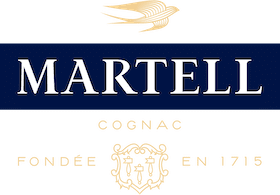What's the difference between brandy and Cognac?

In the realm of fine spirits, few beverages can rival the sophistication and timeless allure of cognac and brandy. Steeped in history and craftsmanship, both cognac and brandy share a connection but boast unique characteristics that set them apart. In this captivating journey, we delve into the intricacies of production, explore the art of tasting, and uncover the beauty of cognac and brandy glasses. Welcome to the world of Maison Martell as we compare cognac vs. brandy.
Do you know the difference between brandy and cognac?
A common question arises: “Is brandy the same as cognac?” These two well-known spirits either share everything in common, or not much at all – depending on how you frame the question.
Confused? Actually, it’s quite simple. While all cognacs are brandies, not all brandies are cognacs. The distinction lies in the geographic origin and production methods, with cognac exclusively hailing from the esteemed cognac region of France.
Brandy has been made for centuries, anywhere wine is made, and can describe any spirit distilled from fermented fruit juice. The name comes from the Dutch word brandewijn meaning ‘burnt wine’, a reference to its distillation with heat. Many countries have their own national brandy, such as Slivivitz in Poland, made from plums.
Cognac is a type of brandy made from grapes that follows very strict production methods. It is specific to the French region of cognac, for which the spirit is named. The region of cognac is divided into six zones, called ‘crus’ – Borderies, Grande Champagne, Petite Champagne, Fins Bois, Bon Bois and Bois Ordinaire.
Compared to other brandies, cognac was quickly recognised for its superior ability to age, the result of high acidity in its grapes.

Production Process
While cognac and brandy may appear similar at first glance, their production processes, and distillation process, mark a fundamental distinction. Cognac is produced according to very strict methods and regulations, which do not apply to other brandies. Cognac, being a type of brandy, is exclusively crafted in the cognac region of France, a geographic privilege that sets it apart from other brandies. Maison Martell cherishes the heritage of cognac production, meticulously adhering to age-old savoir-faire passed down through nine generations.
Cognac’s birth begins with the Ugni Blanc grapes, a revered grape variety known for its contribution to the beverage’s exquisite taste. Harvested grapes are fermented into wine, which then undergoes double distillation in traditional copper pot stills. The clear eau-de-vie, a testament to the House’s expertise, is aged in French oak barrels, during a minimum of two years, where it acquires the rich hues, complex aromas, and velvety texture that distinguish cognac.
Brandy’s production is not confined to a specific region, granting more flexibility to distillers worldwide. The fruity wines are distilled, and the resulting spirits may or may not be aged in wooden casks, allowing for a wide array of flavors and styles to emerge.

Cognac vs brandy taste
At the heart of the comparison between cognac and brandy lies the remarkable contrast in taste. Cognac, a true embodiment of refinement, is celebrated for its elegant and delicate flavor profile. The House of Martell’s cognacs exude notes of dried fruit, subtle spices, and a harmonious balance that lingers on the palate, leaving an enduring impression of sophistication.
On the other hand, brandy encompasses a diverse range of tastes. The spectrum of flavors in brandy offers an array of choices, catering to different preferences and occasions.
What is the difference between brandy and cognac glasses?
Savoring the opulence of cognac and brandy involves more than just the spirits themselves; it also entails the art of using the right glassware. Maison Martell cherishes the tradition of using specially designed tulip-shaped glasses to enhance the tasting experience.
For cognac, the tulip-shaped glass narrows towards the top, allowing the rich aromas to concentrate, while the wide bowl at the base enables the spirit to breathe and develop its complex bouquet.
Similarly, brandy enthusiasts may opt for a balloon-shaped glass, which captures the spirits’ aromas and provides ample space for swirling. This ensures a delightful journey through the varied nuances of brandy’s diverse flavors.
Cognac vs. brandy: A Timeless Choice
In the world of fine spirits, cognac and brandy reign supreme, each offering a distinctive and luxurious drinking experience. Whether you savor the finesse of Maison Martell’s cognac or explore the diverse range of brandies, one thing remains certain: both cognac and brandy boast a legacy of craftsmanship, tradition, and elegance that continues to captivate connoisseurs worldwide. Let your taste journey begin with Maison Martell, where time-honored savoir-faire meets contemporary sophistication.
Legally, any eau-de-vie produced this way that has aged for two years or more can be called a cognac. (Maison Martell makes its own distinction, which is an eau-de-vie, however long it has aged, remains an eau-de-vie until it has been blended.)
Cognacs produced according to these strictly prescribed methods are recognised with the famous AOC label, appellation origine controlée. This sought-after certification verifies the cognac’s authenticity and connection to the region, and sets it apart from generic brandy.
For more detail on cognac and how it is made at Martell, see our craftsmanship section.
PLEASE DO NOT SHARE WITH ANYONE UNDER 18. ENJOY MARTELL RESPONSIBLY.













